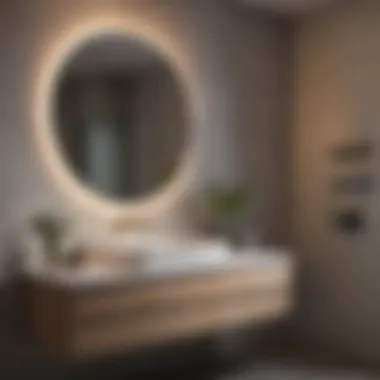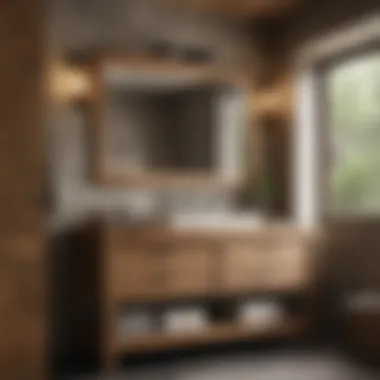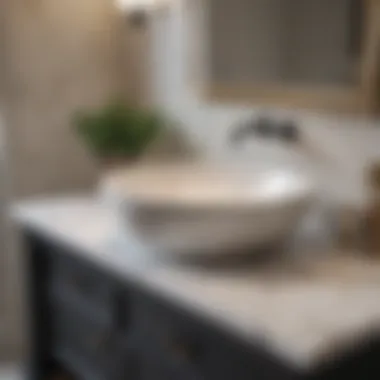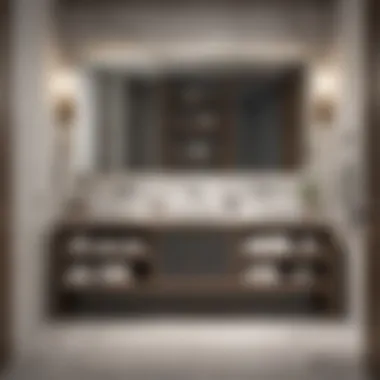Master Bedroom Bathroom Vanity: Design and Functionality


Intro
The master bedroom bathroom vanity serves as more than just a functional fixture; it is a critical component of the master suite's aesthetic and utility. From the moment one enters the space, the vanity often sets the tone for the overall ambiance. Thus, understanding its design, materials, and proper placement is essential for creating a cohesive environment.
This overview will provide essential insights, leaving homeowners and design enthusiasts equipped to make informed choices in selecting or upgrading their own bathroom vanities in the master bedroom.
Design Inspiration
Current Interior Design Trends
Bathroom vanities reflect broader interior design trends. Currently, minimalism and sophistication dominate the design landscape. Clean lines and uncluttered surfaces characterize many modern vanities. Materials such as quartz, marble, and natural wood are favored for their durability and aesthetic appeal. Today’s vanities often integrate technology, with features such as built-in charging stations and smart mirrors.
Mixing and matching styles is also gaining popularity. Combining vintage pieces with modern fixtures can create an interesting contrast and personalize the space.
Color Palettes and Their Effects
Selecting a color palette is crucial in defining the mood of the master suite. Lighter colors, such as soft whites, creams, and pale greens, tend to make spaces feel larger and more airy. In contrast, darker colors add warmth and cozoness, often creating a luxurious atmosphere.
The following color schemes are popular:
- Monochromatic: Different shades of the same color promote harmony.
- Complementary: Using colors opposite one another on the color wheel can create visual interest.
- Analogous: Colors next to each other provide a soothing effect and bring cohesiveness.
Ultimately, the chosen palette should align with the homeowner's personal tastes while also enhancing the physical space.
Functionality and Organization
A master bedroom bathroom vanity should not only be visually appealing but also highly functional. Considerations such as size, layout, and storage solutions are vital.
Key Functional Aspects to Consider:
- Storage Capacity: Ample space for toiletries and linens helps to avoid clutter.
- Accessibility: Ensure everything essential is within reach during daily routines.
- Lighting: Proper illumination around the vanity is essential for tasks like grooming.
Maintenance Concerns
Regular maintenance extends the life of a vanity. Here are some simple tips:
- Clean surfaces with gentle cleansers to avoid damage.
- Inspect and tighten fixtures to prevent leaks and damage.
In understanding the balance of aesthetics and functionality, homeowners can curate a space that not only looks great but serves their practical needs.
"The essence of a well-designed bathroom is not just in its looks, but in its utility as well."
In summary, the master bedroom bathroom vanity plays a significant role in the overall design and functionality of the suite. With careful consideration of current trends, color palettes, and practical elements, homeowners can create an inviting and organized environment.
Preamble to Master Bedroom Bathroom Vanities
Bathroom vanities in a master bedroom are not just functional fixtures. They serve as a central design element that can significantly influence the overall aesthetic and utility of the space. A well-chosen bathroom vanity enhances organization, promotes a sense of calm, and contributes to the overall comfort of the master suite. Their importance transcends mere utility, offering homeowners a blend of style and practicality.
Choosing the right master bedroom bathroom vanity involves numerous considerations. These include the size and layout of the bathroom, the overall design theme of the suite, and the specific needs of the users. Furthermore, vanities can drastically vary in style, from sleek modern designs to ornate traditional formats. Each choice impacts not only appearance but also functionality.
In this section, we will delve into the definition and purpose of bathroom vanities, followed by a brief overview of their evolution to understand their current significance in modern design.
Definition and Purpose
A bathroom vanity typically consists of a sink, countertop, and cabinets or drawers. Its primary purpose is to provide a designated area for personal grooming activities, including washing hands, brushing teeth, and applying makeup.
However, the vanity also plays a significant role in storage solutions, allowing for the organization of toiletries and other personal items. This organization reduces clutter, contributing to a tranquil environment valuable in a master suite. Additionally, the aesthetic aspect of a vanity allows homeowners to express their style preferences effectively.
Thus, a bathroom vanity merges function and flair, making it an essential aspect of any master bedroom’s design.
Evolution of Bathroom Vanities


The concept of the bathroom vanity can be traced back centuries. Initially, they were simple pieces of furniture designed for washing. Over time, they evolved into much more than mere sinks.
Historically, early vanities comprised a basic table with a bowl for washing. As plumbing systems advanced, these became integrated with sinks and cabinetry. In the 20th century, bathroom vanities adapted to modern tastes and innovations in materials. The introduction of laminate surfaces and metal fixtures diversified their appearance and functionality.
In recent years, the rise of the home improvement culture has further transformed vanities into stylish focal points in bathrooms. Homeowners now seek unique designs that reflect their personality while ensuring high functionality. The broad spectrum of choices available today emphasizes individual expression. Therefore, understanding this evolution helps homeowners appreciate the versatility and importance of contemporary bathroom vanities.
Design Considerations
Design considerations for a master bedroom bathroom vanity play a crucial role in shaping not only the aesthetic appeal but also the functionality of the space. Choosing the right design elements ensures that the vanity aligns with the overall decor of the master suite, providing coherence and harmony. Each style type brings its own unique character, which can enhance the overall ambiance and experience within the bathroom. Additionally, integrating factors such as size, proportion, and color schemes into the design process allows for a customized approach that meets the specific needs and preferences of the homeowner.
Style Types
Modern
Modern style emphasizes sleek lines and minimalistic design. The contribution of modern aesthetics lies in its ability to create a clean, uncluttered environment. Key characteristics include a focus on functionality and simplicity, often using materials such as metal and glass. Modern vanities provide an airy feel, which can be particularly beneficial in smaller spaces, making them appear larger. However, some may find the lack of ornate details less appealing, as it can feel stark or cold.
Traditional
Traditional style recalls classic elegance and timeless designs. The hallmark of traditional vanities is the rich detailing and use of classic materials like hardwood. This style is a beneficial choice for those seeking warmth and character in their master suite. Unique features such as intricate carvings and antique finishes add a sense of history. Nevertheless, traditional designs may not fit well in contemporary settings, potentially clashing with modern decor.
Transitional
Transitional style blends elements from both modern and traditional designs. It acts as a bridge between the two styles, maintaining a balance that can appeal to a wide audience. The transitional vanity typically features clean lines combined with slightly more decorative elements. This versatility makes it a beneficial option as it adapts well to various decors, allowing homeowners to mix different styles without conflict. However, its lack of a definitive identity might confuse those seeking a clear design statement.
Rustic
Rustic style captures the beauty of natural elements and raw finishes. Its contribution to the overall design is its ability to create a cozy, inviting atmosphere. A key characteristic is the use of reclaimed wood or stone, which adds texture and character. This style is popular among those who appreciate the charm of nature. Unique features like distressed finishes enhance its authenticity. On the downside, rustic styles may require more maintenance to preserve their appearance over time.
Size and Proportion
The size and proportion of a bathroom vanity are significant factors that influence both aesthetics and usability. It is essential to measure the available space accurately to ensure the vanity fits harmoniously within the bathroom. A vanity that is too large can overpower the room, while one that is too small may feel lost or inadequate. Attention to height, width, and depth in relation to the overall dimensions of the bathroom contributes to an overall balanced effect. Proper proportion also takes into account other fixtures and elements in the space, ensuring a cohesive look.
Color Schemes
Color schemes play an integral role in setting the mood of the bathroom. Selecting the right colors can influence not just visual appeal but also how the space feels. Neutral tones like whites, grays, and beiges create a calming effect, while bold colors can offer a striking contrast or an energetic atmosphere. It is essential to consider the existing color palette of the master suite to create a seamless transition from one area to another. Additional thoughts on incorporating textures and finishes, such as matte or glossy surfaces, further enhance the overall look and feel.
Materials and Finishes
Materials and finishes play a critical role in the design and functionality of master bedroom bathroom vanities. They influence not only the aesthetic appeal but also the durability, maintenance, and overall value of the vanity. Understanding the various materials available and the finishes that can be applied helps in making informed selections appropriate for personal style and practical needs. The right combination contributes to a cohesive and pleasant environment in the master suite.
Common Materials
Wood
Wood is a highly sought-after material for bathroom vanities, recognized for its warmth and natural beauty. It brings a sense of elegance and comfort to the space. The key characteristic of wood is its versatility; it can be finished in many ways to suit different styles, from contemporary to rustic. Hardwoods like oak and maple are robust and long-lasting, making them a beneficial choice. However, wood's vulnerability to moisture may necessitate proper sealing and care, which can be seen as a disadvantage in a bathroom setting.
Metal
Metal, especially stainless steel or brushed nickel, is commonly used for vanities due to its modern look and durability. The main advantage of metal is its resistance to humidity, which makes it a practical option in bathrooms. Metals can be incorporated into hardware, frame structures, or even entire vanities. However, the coldness of metal may not appeal to everyone, as it can feel less inviting than wood.
Glass
Glass offers a sleek and contemporary look to bathroom vanities. It is often used for shelves or as an incorporated feature, allowing for transparency that can make a space appear larger. A key advantage of glass is its ease of cleaning, as it does not retain stains. However, it can be fragile and susceptible to chips or scratches, which could be considered a downside in active households.
Composite materials
Composite materials combine elements for strength and versatility. These can include MDF (medium-density fiberboard), which is often used when a custom shape is required. A benefit of composite materials is their affordability and availability. They can mimic the look of wood or stone at a lower cost. However, they may be less durable than solid wood over time, particularly in moist environments, which should be carefully considered.
Surface Treatments
Surface treatments are just as vital as the materials themselves. They protect the surface and enhance the visual appeal, contributing to the overall functionality of the vanity.
Paint


Paint provides a means to personalize a vanity, allowing for various colors and finishes. This can transform an old vanity or fit one into a specific design scheme. The main advantage of paint is its ability to completely change the look without replacing the entire unit. On the downside, painted surfaces may require more frequent touch-ups compared to stained finishes, as they can chip or peel over time.
Stain
Stain helps to enhance the natural grain of wood while providing protection. It offers a more subtle color choice while maintaining the natural feel of the material. Staining is favorable for those who want to showcase the wood's beauty. However, it may be limited in color options compared to paint, potentially restricting design choices.
Varnish
Varnish creates a hard protective layer over wood surfaces, making them resistant to water and wear. This treatment is perfect for high-moisture areas like bathrooms. A distinctive feature of varnish is its durability, often requiring little maintenance over time. However, it can change the finish of the wood, sometimes leaving a glossy surface that may not appeal to all design preferences.
"Choosing the right materials and finishes is crucial for blending functionality with design in bathroom vanities."
Functionality in Master Suite Design
Understanding the functionality of the master bedroom bathroom vanity is crucial when designing a master suite. The vanity serves not only as a practical element but also as a focal point in the room. Its thoughtful arrangement can dramatically enhance the usability of the space while maintaining aesthetic appeal.
Storage Solutions
Efficient storage solutions are fundamental to keeping the master bathroom organized and clutter-free. A well-designed storage system allows for easy access to essentials, making the morning routine smoother and more enjoyable.
Drawers
Drawers are one of the key components of modern bathroom vanities. They provide a concealed storage option, helping to reduce visual clutter. A well-designed drawer can hold everything from toiletries to grooming tools. Their ease of use is a significant advantage; items can be accessed quickly without rummaging through other products.
However, it's important to consider the limited depth of drawers, which may not accommodate larger items. This can be a drawback for some homeowners. Nonetheless, many prefer drawers because of their organizational capabilities and the clean look they provide.
Shelving
Shelving offers another layer of storage that is both functional and decorative. Open shelving allows for quick visibility and easy access to frequently used items like towels or decorative pieces. This can create a welcoming and personalized atmosphere in the bathroom.
The primary disadvantage of shelving is that it can contribute to a cluttered look if not well managed. Dust can also accumulate more easily on open surfaces, necessitating more frequent cleaning. However, their appeal in terms of design flexibility makes them a popular choice.
Cabinets
Cabinets are essential for comprehensive storage needs. They combine both style and practicality. Cabinets can be customized to varied sizes and styles, fitting seamlessly into the overall bathroom theme. They can store larger items like extra towels or cleaning supplies, maintaining a neat appearance.
On the downside, cabinetry often requires sufficient space, which might be an issue in smaller bathrooms. Additionally, cabinets may limit access compared to open storage options. Despite this, their ability to organize and conceal clutter remains a significant advantage, making them a staple in many designs.
Lighting Options
Proper lighting is one of the most important considerations for functionality. It can greatly affect the usability of the vanity space.
Task lighting
Task lighting is critical for precision-related activities such as shaving or makeup application. Well-placed fixtures can illuminate the face without harsh shadows, enhancing visibility and reducing strain.
A common choice for task lighting includes wall-mounted sconces or pendant lights. However, placement needs careful consideration; incorrect positioning can lead to uneven lighting effects.
Ambient lighting
Ambient lighting serves to create a warm and inviting atmosphere. This light source provides general illumination for the entire space. It can significantly enhance the comfort level in the environment, encouraging relaxation.
Typically, ceiling fixtures or recessed lights provide ambient light. However, it is vital that they complement task lighting to avoid glare or dim areas.
Accent lighting
Accent lighting plays a decorative role while also highlighting specific areas such as artwork or decorative vases. This addition gives depth to the overall design and engages visual interest.
Challenges with accent lighting can include potential overshadowing of task areas if not integrated well. Despite this, its influential presence in elevating aesthetic appeal makes it a worthwhile consideration.
Plumbing and Electrical Considerations
Plumbing and electrical aspects are vital for any bathroom vanity setup. Accurate plumbing can prevent leaks and ensure proper water flow to sinks, while electrical connections must be feasible for lighting and appliances. Homeowners should consider consulting professionals to handle these installations.


Integration with Overall Decor
The integration of a master bedroom bathroom vanity with the overall decor is crucial for creating a harmonious living space. A well-coordinated vanity not only enhances the beauty of the bathroom but also complements the overall design narrative of the master suite. This section will explore key elements that play a role in achieving this seamless blend, focusing on specific components, benefits, and considerations.
Complementary Elements
Countertops
Countertops are one of the most visible and emphasized features of a bathroom vanity, making their selection essential for decor integration. The material of a countertop significantly influences the visual appeal of the vanity. For example, materials like quartz are highly favored due to their durability and low maintenance. Quartz countertops also offer a variety of colors and patterns, making it easier to find a match for existing decor.
The unique feature of quartz is that it is non-porous, which helps prevent staining. However, it can be expensive compared to other options. Homeowners should weigh the aesthetic benefits against the cost.
Backsplashes
Backsplashes serve both a protective and aesthetic function in a bathroom vanity setup. They help shield walls from water and stains, while also providing an opportunity for artistic expression. Popular materials for backsplashes include tile, stone, and glass. Each of these can add texture and personality to the space. For example, a subway tile backsplash can create a classic look, whereas a glass mosaic adds vibrancy.
The enhancement that backsplashes provide allows for more creative freedom in decor. They can be chosen to either contrast with or complement the countertops. However, complicated designs may add to maintenance. Thus, simple yet effective designs are usually preferable.
Mirrors
Mirrors are critical in integrating the vanity into the master suite design. The size and frame of the mirror can significantly impact lighting and perceived space. A well-placed, large mirror can enhance natural light and make the bathroom appear larger, thus improving functionality and aesthetic appeal.
Framing options range from minimalist to ornate, and the choice often reflects the style of the entire bathroom. For example, a sleek, frameless mirror is ideal for a modern design, while an antique frame might suit a traditional or transitional space. The benefits of mirrors generally include creating depth and functionality, but improper placement can cause glare or disrupt the visual flow.
Balancing Aesthetics and Practicality
Achieving a balance between aesthetics and practicality is paramount in the design of a master bedroom bathroom vanity. Homeowners should focus on the functional needs of the space while ensuring that the design aligns with their personal style. Considerations include the frequency of use, available storage, and the need for easy maintenance. Design choices should not only look appealing but also serve the daily needs of the users effectively.
To ensure a cohesive look, attention to details like hardware, lighting, and color should be maintained throughout. When the vanity successfully merges aesthetics with functionality, it enriches the entire master suite environment, creating a truly inviting space.
Maintenance and Care
Maintaining a master bedroom bathroom vanity is essential for both aesthetic appeal and functionality. Proper care ensures not only longevity but also keeps the space enjoyable and hygienic. The right maintenance practices can help prevent damage, preserve finishes, and maintain organization. This section will cover important cleaning techniques and preventative measures that should be implemented in order to sustain the vanity's elegance and usability.
Cleaning Techniques
Regular cleaning of the bathroom vanity is vital. The surfaces of a vanity can accumulate dust, grime, and moisture, especially in a setting involving water use. Recommended cleaning methods include:
- Daily Wipe-Down: Using a soft, damp cloth can remove surface dust and smudges. A microfiber cloth is ideal as it doesn't scratch.
- Mild Cleaning Solutions: For deeper cleaning, utilize a mix of warm water and a few drops of mild dish soap. This solution can be used on most finishes, but always test on a small, inconspicuous area first.
- Avoid Harsh Chemicals: Bleach-based or abrasive cleaners can cause irreversible damage. Stick to gentle, non-abrasive cleaners.
- Glass Surfaces: If your vanity has glass components, a glass cleaner can keep them clear. Ensure it’s streak-free with a dry microfiber cloth.
Implementing these cleaning techniques frequently will help in maintaining a fresh look and ensure the materials are not compromised over time.
Preventative Measures
Preventative measures play a significant role in extending the lifespan of your bathroom vanity. Here are some effective practices to consider:
- Sealant Application: If the vanity is made of wood, applying a sealant can protect it from moisture damage. This is particularly crucial around sink areas where water exposure is frequent.
- Water Resistance: Ensure any seams or joints around sinks are properly sealed with silicone. This helps prevent water from seeping into unwanted areas.
- Regular Inspections: Routinely check for signs of damage or wear, such as scratches, varnish degradation, or peeling paint. Addressing these issues early can prevent more extensive repairs later on.
- Decluttering: Regularly assess what is stored in the vanity. Keep only essentials to avoid overcrowding, which can lead to disorganization and easier wear on the materials.
The more attention you give to maintenance, the easier it will be to keep your vanity looking new and performing well.
By incorporating these cleaning techniques and preventative measures, you not only enhance the lifespan of your master bedroom bathroom vanity but also ensure it remains a central piece in your overall bathroom design.
Finale
The conclusion of an article serves as a vital component, synthesizing the core elements discussed throughout the text. In the context of master bedroom bathroom vanities, this section holds significance as it reinforces the importance of well-considered choices in design and functionality.
Recapitulation of Key Points
In reviewing the essential aspects of master bedroom bathroom vanities, several points stand out:
- Definition and Purpose: Understanding what constitutes a bathroom vanity and its role in a master suite is fundamental. It is not merely a functional element but a central feature that can define the overall aesthetic.
- Design Considerations: Various styles, sizes, and colors allow homeowners to express personal taste. Balancing these considerations against the space available is crucial for a cohesive look.
- Materials and Finishes: The selection of materials impacts not just the appearance, but also durability and maintenance. Choices between wood, metal, and glass must align with lifestyle needs and preferences.
- Functionality: Prioritizing functionality with adequate storage and proper lighting is essential for the daily use of these spaces.
- Maintenance: Practical tips on cleaning and preventative care enhance the longevity of a vanity, making it a worthwhile investment.
Future Trends in Bathroom Vanity Design
The landscape of bathroom vanity design is constantly evolving. Homeowners and designers alike are steering towards several emerging trends:
- Sustainable Materials: An increasing emphasis on eco-friendly options influences material choices. Bamboo and reclaimed wood are becoming popular for their environmental benefits and aesthetics.
- Smart Technology Integration: Advancements in technology introduce features like smart mirrors and touchless faucets, enhancing functionality and convenience.
- Customization: More homeowners are seeking custom solutions that fit their unique spaces and specific needs, leading to a rise in bespoke vanities.
- Minimalist Designs: The minimalist trend promotes simplicity and efficiency, favoring clean lines and uncluttered spaces without sacrificing elegance.
In summary, the conclusion encapsulates the multifaceted nature of master bedroom bathroom vanities. By understanding their significance and considering trends, homeowners can make educated decisions, ensuring their choices are not just aesthetic but also functional and future-proof.















